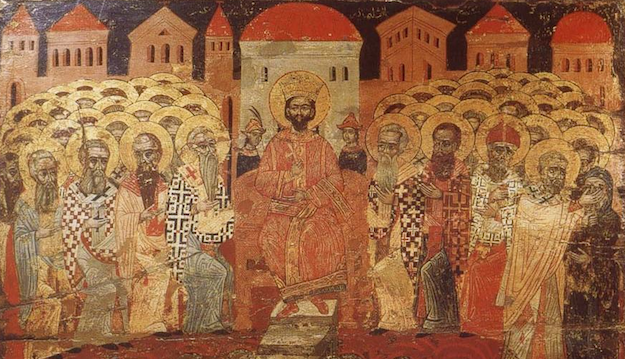I love to travel. In fact, I am secretly envious of guys like Rick Steves who make travel shows for a living. There is nothing like going to a foreign country that is rich in history and cultural diversity. I have had the opportunity to travel quite a bit and on a number of occasions have been blessed to have some amazing tour guides. There is something unique about having someone who not only takes you to historical locations, but who also takes you into the ancient past in order to brings those locations to life.
The first time I visited the Vatican I was mesmerized by its history and stunned by its beauty. I was also overwhelmed. Thankfully I had a very wise and capable guide. Without him I would have been lost. Sure I would have come home with a lot of pictures and stories to tell, but I would have missed out on so much. My experience of the Vatican would have been from a single perspective—my perspective.
Christianity is in many ways like traveling to a famous historical location. We are certain to see things only from our limited perspective and we are sure to miss a lot if we have only ourselves as a guide. The sad truth is that many Christians are traveling without a guide. And while some may have a guide, or even several guides, often they are traveling with a guide from a niche market.
In the travel industry you can find certain guides who specialize in “extreme travel” or some other niche within the travel industry. These “extreme travel” guides may take you on an adventure tour up a mountain, but they may possess no knowledge of the history and archeology of the ruins on the mountain—the very things a well-rounded tour guide would know. When it comes to Christian faith and practice, many of us have found niche guides. These guides may be competent in the latest theological fad, but, like the “extreme travel” guide, they are not competent in guiding us into the ancient past so as to connect us with the many facets of Christian faith and practice found throughout the church.
John Armstrong writes the following in his important book, Your Church is Too Small:
New patterns of Christian faith and life are emerging in the church. I welcome these patterns, but I believe they desperately need to be rooted in the past—the creeds, the Word of God understood as the story of grace, life as a sacramental mystery, and deeply rooted spiritual formation. My thesis is simple: The road to the future must run through the past. (Your Church Is Too Small, p.17)
I completely agree with Armstrong—the road to the future must run through the past.
He goes on to say:
True Christian faith is not found in personal religious feelings but in the historical and incarnational reality of a confessing church. Therefore, if we refuse to come to grips with our past, our future will not be distinctively Christian. The result will be new forms of man-made religion that embrace recycled heresies.
For almost two thousand years, Christians have lived the mystery of the apostolic faith and passed it on through personal stories, sermons, creeds, and common practices. But American Christians have a unique predilection to approach the Christian faith as if what we know is vastly more relevant than what pervious generations knew. To do so is naïve at best and dangerous at worst. It has led a generation of Christians to assume that they know perfectly well who Jesus is, apart from any instruction in ancient Christian tradition. (Your Church Is Too Small, p. 18)
I find that many people resonate deeply with Armstrong’s comments, but few of them know what to do about it. Mention of the church fathers may mean nothing more to them then the men in their church who have children. The ancient church is a mysterious and seemingly inaccessible place to them.
What most of us need are some really great guides—experts who can lead us to the ancient past. As any good friend would do, I want to recommend a couple of reputable guides for your journey. These are obviously not the only guides I would recommend, but these are some of the most accessible guides for those new to the journey [1].
The late Robert Webber played a major role in my own journey. His book, Ancient-Future Faith (along with the rest of his Ancient-Future series), was instrumental in shaping my understanding of the significance of classical Christianity[2] to interpret my own experience:
Allow classical Christianity to interpret you and your world by putting yourself under the communal authority it holds in the life of the church. By allowing classical Christianity to act as interpreter with yourself as the interpreted, you will avoid the dead-end street of modernity, which proudly thinks the human is autonomous and the individual mind is the final arbiter of truth. (Ancient-Future Faith, p. 34)
Webber created in me a desire to know the church fathers, but it was Christopher Hall who helped me walk into their world. His three books, Reading Scripture with the Church Fathers, Learning Theology with the Church Fathers, and Worshiping with the Church Fathers, are essential reading for anyone who wants to begin to understand the world of the patristics. While Webber had taught me to allow classical Christianity to interpret my own experience, Hall taught me to allow classical Christianity to show me how to interpret the Bible.
Indeed, all the fathers insist that the study of the Bible is not an esoteric, intellectual exercise practiced by the isolated academic. Instead, the fathers argue that biblical interpretation is an ecclesiastical activity to be practiced in the church and for the church within the context of prayer and worship. It is a communal act rather than a private, individualistic endeavor…In short, the fathers consistently treat the Bible as a holy book whose riches can be mined adequately only by those prepared to honor and obey the message the Scripture contains. (Reading Scripture With The Church Fathers, p. 9)
It is impossible to be exposed to the church fathers without having to think deeply about the way that you approach life and the Christian faith. One who is immersed in classical Christianity cannot help but be aware of how limited his or her own perspective is on the Christian tradition. Actually, it is probably not accurate even to speak of THE Christian tradition, as if there is only one. The more I was immersed in classical Christianity the more I realized that within the one faith there were multiple traditions.
Richard Foster introduced me to the great traditions of the Christian faith and was therefore instrumental in my journey toward catholic spirituality. His great work in Streams of Living Water: Celebrating the Great Traditions of Christian Faith gave me a framework for understanding the six dimensions of faith and practice that define the Christian tradition—The Contemplative Tradition, The Holiness Tradition, The Charismatic Tradition, The Social Justice Tradition, The Evangelical Tradition, and The Incarnational Tradition. As you can see, just by the names of these various traditions, it is foolish to assume that any one tradition has rightly understood the totality of Christian faith and practice.
This is why classical Christianity, steeped in the writings of the fathers and shaped by the creeds, is the path to Christian unity. [Tweet This]
When we engage with the past, along with competent guides, we enter into a dialogue with the universal church and are able to recognize that our one confession—Jesus is Lord—is a confession that has been made by men and women of various centuries, various ethnicities, and various theological backgrounds.
Perhaps we will embrace our Christian brothers and sisters from the past and they will become our companions and introduce us to our Christian brothers and sisters in the present.
I see a people…I see a people…even though it feels as if I am peering through a glass darkly.
I see a country pastor from Indiana embracing an urban priest from New Jersey and together praying for the peace of the world. I see a people.
I see a Catholic monk from the hills of Kentucky standing alongside a Baptist evangelist from the streets of Los Angeles and together offering up a sacrifice of praise. I see a people.
I see social activists from the urban centers of Hong Kong joining with Pentecostal preachers from the barrios of Sao Paulo and together weeping over the spiritually lost and the plight of the poor. I see a people. (Streams of Living Water, p. 274)
— [1] In addition to Robert Webber, Christopher Hall, and Richard Foster, I would also highly recommend the work of Thomas C. Oden in Classic Christianity: A Systematic Theology and the Ancient Christian Commentary on Scripture series, for which Oden is the general editor. [2] Classical Christianity is a way to describe the ancient practices and confessions of the catholic church, both East and West. The word is increasingly used as a way of referring to the importance of tradition in the history of Christianity. (John H. Armstrong, Your Church Is Too Small, p.201)






Missio Alliance Comment Policy
The Missio Alliance Writing Collectives exist as a ministry of writing to resource theological practitioners for mission. From our Leading Voices to our regular Writing Team and those invited to publish with us as Community Voices, we are creating a space for thoughtful engagement of critical issues and questions facing the North American Church in God’s mission. This sort of thoughtful engagement is something that we seek to engender not only in our publishing, but in conversations that unfold as a result in the comment section of our articles.
Unfortunately, because of the relational distance introduced by online communication, “thoughtful engagement” and “comment sections” seldom go hand in hand. At the same time, censorship of comments by those who disagree with points made by authors, whose anger or limited perspective taints their words, or who simply feel the need to express their own opinion on a topic without any meaningful engagement with the article or comment in question can mask an important window into the true state of Christian discourse. As such, Missio Alliance sets forth the following suggestions for those who wish to engage in conversation around our writing:
1. Seek to understand the author’s intent.
If you disagree with something the an author said, consider framing your response as, “I hear you as saying _________. Am I understanding you correctly? If so, here’s why I disagree. _____________.
2. Seek to make your own voice heard.
We deeply desire and value the voice and perspective of our readers. However you may react to an article we publish or a fellow commenter, we encourage you to set forth that reaction is the most constructive way possible. Use your voice and perspective to move conversation forward rather than shut it down.
3. Share your story.
One of our favorite tenants is that “an enemy is someone whose story we haven’t heard.” Very often disagreements and rants are the result of people talking past rather than to one another. Everyone’s perspective is intimately bound up with their own stories – their contexts and experiences. We encourage you to couch your comments in whatever aspect of your own story might help others understand where you are coming from.
In view of those suggestions for shaping conversation on our site and in an effort to curate a hospitable space of open conversation, Missio Alliance may delete comments and/or ban users who show no regard for constructive engagement, especially those whose comments are easily construed as trolling, threatening, or abusive.